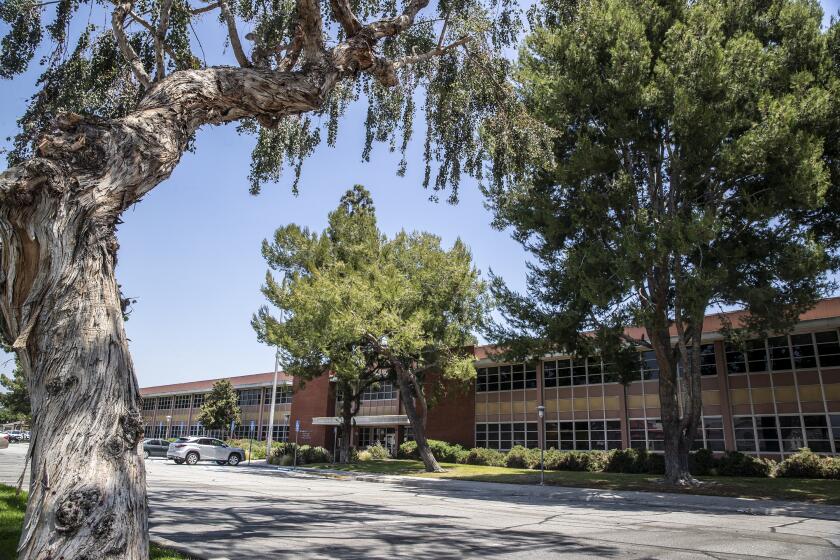The Hand of God and Theirs
- Share via
Five hundred years from now when people stand and marvel at the soaring adobe-colored structure at Temple and Grand in downtown Los Angeles, they will learn the names of Jose Rafael Moneo, the cathedral’s architect, and Cardinal Roger M. Mahony, the man who conjured it to life.
Perhaps they will even take away the name of sculptor Robert Graham, who built the 25-ton Great Bronze Doors, or John Nava, who designed the tapestries that line the nave.
But visitors of the future will never hear of Juan Hernandez, a carpenter from Mexico who worked on the Our Lady of Angels Cathedral for five years, or Eleazar “Chay” Contreras, the layout superintendent who plotted the angles of the cathedral in three-dimensional space, or Dana Baker, a marble mason who laid stones in the floor, and granite in the baptistery. Nor will they learn the names of Charles Coury, who hid scriptures in the rafters, or Dennis Paoletti, who calculated the way sound will reverberate through the basilica, or Francis Krahe, whose lighting turns the cathedral at night into a giant lantern.
No one has exact numbers, but C. Terry Dooley, senior vice president of Morley Construction, who worked at the cathedral for six years, estimates that 2,000 people worked on the $200-million cathedral complex downtown from start to finish.
These are some of the invisible ones, whose hands laid the stones, poured the concrete, placed the alabaster in the windows, laid the wires. But unlike the theaters, apartments, casinos and malls that are their livelihood, some craftsmen and construction workers also invested something of themselves in this cathedral.
Dooley said the workers’ tangible investment in the building was part of Moneo’s plan. When the contractor proposed casting the adobe-colored concrete off-site, and transporting it downtown--which would have been easier--Moneo called the idea “an abomination.”
“I want to see the hands of the workers,” Moneo told them.
Some of these artisans and tradesmen believe God chose them for this job. Others prayed for guidance on the site, as the enormity of the task withered their courage. Still others found themselves--unexpectedly--caught under the spell of the sacred space.
Those who worked on it like to say--although they are not strictly correct--that there are no right angles in this cathedral. There are certainly few.
All the points of the structure, every corner, every wall of every chapel, the baptismal, the floor, was ultimately measured from a single point at the corner or Temple and Grand using a piece of computerized surveying equipment called a digital theodolite. The tool used lasers projected into space to plot the corners of the building.
Contreras was the layout superintendent on the project. In order to construct the 800-plus angles, he plotted more than 11,000 points. “We have to shoot the three dimensional point coordinates into the middle of gravity so we can build to that point,” said Contreras, a slight man with bright eyes, fine features and a boyish enthusiasm that makes even his most esoteric point sound fascinating.
Last Tuesday morning, he pointed with pride at some of the sharpest corners, the difficult angles, the canted slope of the chapels of the ambulatory and the radiating web of floor stones.
Everything that followed--the placement of wooden forms built by carpenters, the pouring of concrete by laborers--depended on Contreras having perfectly plotted the points. If a wall was off by even an inch, workers had to fight the tiny error from floor to roofline or the corner had to be remade. “The work was so intense,” Contreras said. “There were instances on the job site when I looked up at the sky and I said, ‘Help me, God.’ I had this responsibility. I really didn’t want to make an error. I believe God helped me and there it is.”
The hours were crazy. The concrete had to be poured in the inky blackness of early morning--at 2:30 or 3 a.m.--to keep the water below 70 degrees and ensure hundreds of years of durability. Riding high on the building, as the sun rose over the city, were some of the best times for Contreras.
“Oh, it was great,” Contreras said. “There were moments when you were up in the sky and you could see all the downtown high rises, and the mountains, and it just felt like you were going to heaven.”
Through months of taking measurements and calculating points, Contreras eventually came to understand in his bones the symbolic language of the building, just as Moneo hopes visitors will. It happened one day inside the cathedral, as Contreras plotted the axes of the church, and the floor stones that radiated from the altar. “I realized it was a cross,” Contreras said. “Then I would think, when I was working at the back of the church, I am working on His right foot.... Just by knowing I worked on the cathedral, to me it was like a gift of God. Like I was born to be building His house.”
Dream Job
Juan Hernandez, 50, is a carpenter, like his father, his grandfather, and his great-grandfather before him. Like Jesus.
Hernandez worked on the cathedral site longer than any other workman. He was known for the cowboy-shaped hard hat he wore on the job; the cardinal liked to tease him about it. Hernandez grew up in San Miguel de Allende, just blocks from that city’s colonial cathedral. His ancestors built furniture, cabinets, guitars and pianos, and so has he. For Hernandez, who is Catholic, this was the job of a lifetime. “I never understand the mind of the Lord, what he has prepared for me,” Hernandez said. “But I know he wants me here, that he chose me to be here. This was like the culmination of my career.”
The job strained every skill he had. Hernandez worked on many walls in the cathedral, including the main northeast wall and the Guadalupe chapel. None of the forms he built had square angles; all were mitered.
Over five years, as his life changed dramatically, the cathedral offered him solace and strength. His wife grew ill. He would leave her in the morning, knowing as he left, that she might not be alive when he returned. On those days, he would try to be the first person in the building, and he would pray. When the sun came up, he thanked God for a new day. Sometimes he got to see the sun set, and he thanked God for that too. Sometimes he sang as he worked, happy just to be alive. Working on the cathedral was peaceful, he said, and he would have done it for free.
Last spring , when the worst finally happened, his work was a salvation.
“She died on a Friday night,” he said. “Monday, I was ready for work,” he said.
“My children, my grandchildren, they will know, my father, my grandfather worked there,” Hernandez said.
“I know it is a minor thing I did. It’s like the sand of the sea, of the seashore. But little by little you make the big picture. I am one of those particles of sand. But I am there.”
Craftsmen Remembered
Mike Flucke, an executive with Benson Industries of Portland, Ore., which handled the alabaster and glass, often talked to his workers of their historical role. “Five hundred years from now,” he would tell them, “people will look back and wonder about the craftsmen, just as we look at the cathedrals of Europe, and wonder about their craftsmen.”
Flucke has visited museums to see the ropes, pulleys and ramps medieval builders used to erect their monuments. Many of them, he said, weren’t so different than what was used on this project. His men, who built the steel that held the windows, and placed the alabaster in the lantern where the cross hangs, sometimes had to scramble as many as eight stories of scaffolding to start their work day.
“We were up there in the middle of space,” said Al Galvan, who was in charge of the huge concrete cross that dominates the east wall of the cathedral, and is surrounded by veined alabaster that glows at night like a giant beacon. “We had to use a lot of imagination, a lot of new techniques. We had new ways of doing things.”
Eddie Lohr, 53, is a partner in Carnevale & Lohr, the company that installed the stone flooring, the altar, the baptismals, the fountains in the plaza, the courtyards and mausoleums. Lohr oversaw 40 to 45 men for almost two years. Lohr is Lutheran, but his company has worked on about 20 Catholic churches over the last two decades. The cathedral, he said, was a humbling project. At times he became overwhelmed by the magnitude of the job and the timetable. He would ask God to help him get from one day to the next. He discovered in himself a new kind of perfectionism. Sometimes, after a long day, he’d be on his knees until 9 p.m., ripping out stones that weren’t perfectly laid. “Because when you are working on a cathedral, doing work for the church, for God, it has to be right.”
*
Beaming Inspiration
Those who raise their eyes to the geometric beams that crisscross the ceiling will be looking at one of the cathedral’s secrets.
Craftsmen who work on them often hide their signatures in rafters. But in July, Charles Coury, manager of the WoodCeilings Inc., the company that made the ceilings, had an inspiration. He wrote to the cardinal: “We would like to staple a Bible verse to the hidden inside portion of one of the ‘logs’ in order to honor the Lord and acknowledge the privilege we have felt working on this project.” He asked the cardinal to select a verse, if he thought it was appropriate.
The cardinal was delighted. “You are most likely the first supplier on the Cathedral Project who has made such a magnificent request, and I commend you for it!” Mahony wrote back, and chose five.
Mary Tyler, WoodCeilings co-owner, chose four more. The nine verses are clustered in the rafters nearly 100 feet above the altar. Matthew 7:8 is directly over the altar, in a spot where the logs intersect: “In my house, says the Lord, everyone who asks, receives; and the one who seeks, finds; and to the one who knocks, the door will be opened.”
The scripture project pulled the little company together; employees signed each scripture card before it was laminated and stapled to a log. Now the scriptures are a secret, known to only a few.
“To walk through and look up and know that one of my prayers is up there, one of the scriptures that I personally selected, it is a wonderful, thrilling, humbling thing,” Tyler said. “There are few times in your life when you are part of a great work. This is one of them.”
More to Read
Sign up for Essential California
The most important California stories and recommendations in your inbox every morning.
You may occasionally receive promotional content from the Los Angeles Times.










